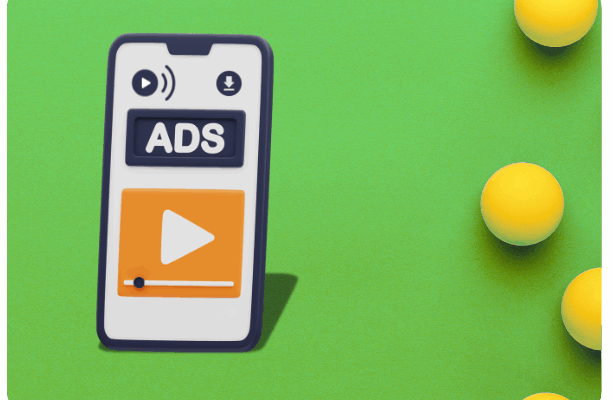
DesignCrowd: Podcast Sponsorships are Always On
This is a deep dive into DesignCrowd and the long-tail success they’ve had with podcast sponsorships. It’s an example of the results you can achieve with sponsoring podcasts.
As the founder of a podcast advertising agency–and someone who has worked on hundreds of campaigns–I can tell you that most podcast sponsorships prioritize short-term results. As sponsors grow in this space, however, they start to recognize the incredible value of the long tail.

No Podcast Advertising Analysis is Complete without the “Long Tail”
What does “long tail” mean? It means the staying power of a podcast ad and its ability to drive long-term return on investment (ROI). Beyond immediate results, a single podcast sponsorship can continue to generate new business for weeks and months after its release.
Statistically, most podcasts get the majority of their listens in the first week. Podcast advertising rates are often based on downloads and streams in the first 30 days of release. When you look beyond that time period, it’s easy to see the huge bonus those additional listens can be for sponsors.
This additional ROI can be due to a few different scenarios.
For instance:
- Listeners hear an older episode and the ad at a later date.
- Or listeners recall the podcast sponsor when a relevant need arises.

We recently spoke with Kevin Bradford, Content Marketing Manager at DesignCrowd.
DesignCrowd is a crowdsourced graphic design platform, primarily aimed at businesses and entrepreneurs. This interview is a podcast advertising deep dive into the power of the long tail, which is a key part of DesignCrowd’s podcast advertising strategy.
Disclaimers
- As with all, DesignCrowd’s experience may be unique (and your results may vary).
- Our podcast advertising agency, ADOPTER Media, has done business with DesignCrowd on a few of their podcast ad campaigns.
Without further adieu, here’s our conversation.
Podcast: Play in new window | Download (Duration: 19:46 — 18.4MB)
Subscribe: Apple Podcasts | Android | Google Podcasts | TuneIn | RSS
Glenn Rubenstein from ADOPTER Media talks to Kevin Bradford from DesignCrowd
Glenn Rubenstein: Kevin, thanks for joining me. To start with, for those who don’t know, what is DesignCrowd?
Kevin Bradford: Yeah, well, thanks for having me, Glenn. DesignCrowd is an online website that allows customers, small businesses, entrepreneurs to outsource or crowdsource custom logo, web, and graphic design from designers all around the world. So, if you’re a small business and you need a new logo you can submit a brief to DesignCrowd. We will send that brief out to our community of 550,000 designers and within days you’ll have a whole selection of other logos and designs that you can choose from, any project receives between 60 and 100 different designs, and you select the best one and put that forward for payment for the design. You get the logo and the designer gets paid–wherever they are in the world.
DesignCrowd’s Podcast Advertising Strategy
Glenn: How big a part of the overall DesignCrowd marketing is podcast advertising?
Kevin: Podcast advertising is a relatively new part of our marketing campaign. We’ve been doing it just coming up to a year now and it’s been a massive learning curve for us, but it’s become an important part of our whole marketing strategy. And obviously one of the key things is making sure it incorporates into a lot of the other things you do. So, whether that’s email campaigns or other social media advertising, it all has to work together to get your message across, engage the right audience and reach as many people as possible.
How DesignCrowd Got Started Sponsoring Podcasts (and what they’ve learned)
Glenn: You mentioned the learning curve. What do you feel that you’ve learned from your first year of running podcast advertising campaigns?
Kevin: A huge amount. It was almost an accidental channel that we came across it. We spent on podcasts…and the initial results of that spend, and we’re talking within the week first week-first month, wasn’t great. We saw a couple of sales, but we thought well for the spend, it hasn’t been through the roof. We didn’t think it was going to move the needle in terms of the number of sales and the amount of revenue it’s going to bring in.
Then we continue to sort of move on with our other advertising channels, marketing elements that we do. We saw that some of these podcasts that we featured on kept appearing in our post-purchase survey that we ask our customers where they heard about us, in the google analytics that we go through, the touch-points on our website we saw still traffic going through to these partner pages that would set up their landing pages for the podcasts.
So when we drill down on that we notice that from the initial spend to the total sales–maybe six months later it had become a really profitable channel. And it really sort of…that’s when the light bulb sort of switched on and we thought we could definitely drill down into this and look at analyzing the tail of that spend that we have on certain podcasts and then sourcing podcasts that we need to part of and work with.
Recognizing The Power of Podcasts through the Long Tail
Glenn: So it did prove to be cost effective, it just took a while to really kick in.
Kevin: Yeah absolutely it was, it was that sort of six months, it was almost as if we forgotten about it. We made that spend which we thought OK that didn’t work–let’s move on, let’s look at other avenues. So from seeing that keep emerging in our in our data, we then basically specked out what we thought that tail would look like per spend and then what it would look like if we spend X amount on certain shows, and that kind of drove the desire, I guess, to find out more about the industry and not be as reliant on immediate sales for immediate spend. Let it sort of live a little bit, breathe as it were, and and say what over time the evergreen content was going to bring in for us.
Prioritizing The Long Tail
Glenn: Long-tail results are something that I hear about from many podcast advertisers. In your case do you think it’s that people didn’t have the immediate need for DesignCrowd so when it came up, when the need arose that you were there destination based on the podcast, or what do you really credit for that long-tail of trickling in results.
Kevin: There’s probably a couple of elements to it.
One that the product isn’t something that you’d necessarily go straight to a website and purchase, if you’ve got a business name and a design name then maybe that’s the case. But in terms of needing design product its one of those things that you may need in future. So once you know about the brand from listening to the podcasts it may be a few days, weeks, before you actually come to purchase a product that you need. So there’s one reason why there may be that tail or that slight delay.
But also podcasts from our experience, just get bigger over time. The content is evergreen and so just because the podcast goes out on a Monday doesn’t mean people are going to be listening to it withn that seven day period or even within that month.
A lot of podcasts do a lot of good work in terms of putting those podcasts on their website and getting some SEO values when people are searching for how they’re going to build their business or looking for tips and hints on how to grow their entrepreneurial idea, these podcasts pop up and maybe six months later someone is listening to that not in necessarily the sequence that it was uploaded. They’re just listened into it for that information and if we’re part of that discussion as an advertiser then they were going to look to come to our site and use our product.
DesignCrowd’s Current Podcast Advertising Plans
Glenn: How many podcasts are you currently sponsoring, now in 2017?
Kevin: We are probably down to a streamline of maybe 10 podcasts that we’re working with, probably in total we’ve worked with maybe 30 to 40 different podcasts for various amounts of time and that’s the key thing. You’ve got to test the show. There’s nothing on paper you can look at that says that podcast is going to work for me.
It can take all the boxes on paper, and then for some reason it just won’t resonate. And so you have to, from our experience, get on the podcast. Make the spend. Do as much as you can to get the reads right to get the website looking right. This is just coming to the page, and ensure the offer is there for people to take up and just ... test, test, test. And so once you know which podcasts are working best for you we kind of rolled back to our core podcast group that we know is successful. And from that try and add in new ones that we think are in the same kind of ballpark.
The Podcasts That Work Best for Them
Glenn: What types of podcasts have been the most successful for you?
Kevin: Well it’s interesting, because we obviously started out with the with the idea that entrepreneur, start-up, small business podcasts were going to be the thing. They’re going to be listened to by the people who need design products or design assets and people who are looking out for a new idea, a new way to push their business and grow their business. And we thought it was going to be the absolute sweet spot and some of those podcasts have worked well for us and we continue to work with them. Others have been more along the lines of self-improvement, motivational podcasts.
Podcasts that talk more about lifestyle and how to make the most of what you’re doing in business and in life in general. And it seems like a lot of people who listen to those podcasts have an entrepreneurial way about them and who probably wouldn’t turn themselves entrepreneurs. But we see a lot of things like fitness instructors getting logos, and bakers and home cooks and people who really have their own brand that they want to improve, and wouldn’t necessarily think of it as a business more of a bit of branding, and they use us for their logos and leaflets, flyers and everything else they need.
Surprise Success in Motivational Podcasts
Glenn: Has there been any genre of podcast that has been a surprise success for you?
Kevin: In terms of surprise success is probably the motivational podcasts. We did, we just, because it’s more lifestyle based and when you listen to some of those podcasts that the stories are quite emotive. People have been through some hard times, and they really want to inspire the listeners to make the most of what they’re doing in their own lives and find a way to find bigger and better ways to live their life. And, and we didn’t think that necessarily it was going to be an area that that people were going to need design and logos and websites and graphic design. And, and it’s proved really successful and it has been somewhat of a surprise that that’s the audience that particularly resonates.
Podcast Attribution – Going Beyond Offer Codes
Glenn: That’s really interesting. I mean, just the idea that you started in one genre thinking that was going to be the one and then adjacent genre is the one that’s really delivered for you. How do you measure success? Has it strictly been the use of offer codes and URLS?
Kevin: The finding a way to measure the success of podcasts is one of the biggest obstacles, I guess, that we’ve had to overcome, because it’s not as simple as tracking the traffic that comes through on analytics. It’s not as simple as just looking at who’s used to discount code because you can set up a landing page. But if people don’t come to that landing page and they just come to the website you might lose them, then they don’t use the discount code, and the podcast has ultimately been successful in driving people to the site, but you’ve kind of missed it from those sort of traditional ways of just tracking online traffic.
So, one of the biggest things is ensuring that we’ve got a post-purchase survey, where we ask our customers where did they hear from us or hear about us, and that has delivered a lot of results in terms of clarity around which podcast people are listening to, where they came from, and how that how that relates to the number of discount codes that are being used or we can look at if customers have used a discount code.
And from all that we can compare customers that say they’ve heard of us from a podcast with their project for example and say have they actually used that discount code. Did they visit the landing page at any point? And sometimes you realize that they haven’t used that discount code and they’ve just jumped straight in and use their web site without going to the landing page and it means we would have missed those if we’d just been looking at say Google Analytics data.
So it’s a real mix of ways to understand just exactly how engaging those those adverts are. There are also some leading indicators. Initially the first day after a podcast goes out you do want to see some clicks to that landing page, you do within the first week want to say a reference to some customer registrations in the Google Analytics, but just going off that isn’t giving you the whole understanding of how well the advert might well be doing.
The Brand Halo and Personal Endorsements
Glenn: That’s really interesting you do the follow-up survey to figure out where people were coming from. Not everyone uses an offer code or a URL. It’s just the reality, some people forget, or they just don’t bother to. What have you seen of additional benefits, sort of a brand halo, that podcast advertising has given you? Aside from just the offer codes and URLS and the post sign-up surveys, have you seen sort of an overall brand-lift where people are talking more about DesignCrowd because they learned about it on podcast advertising and then passed along the recommendation?
Kevin: That’s probably even more difficult to track in terms of having some tangible numbers on it. But what we do feel is being part of the discussion is certainly going to be beneficial for us where we’re on the podcasts. Not only do we feel a start-up and entrepreneur leaders are listening to which helps us become part of the discussion. We’re also on those podcasts with influencers and obviously the influence of marketing is becoming quite a big thing.
And although it’s paid for advertising, having some of the shows hosts talk about DesignCrowd, often in a really personal and genuine way, because they have used our product and they have used the service and got a design result at the end of it, really helps explain the process the product and what the benefit is of using DesignCrowd, which really helps customers and listeners understand what we’re doing and obviously moving forward, hopefully come back to us regularly. And as you say talk to other people about using the service and using DesignCrowd as a as a referral.
Selecting New Podcasts to Sponsor
Glenn: Definitely, definitely. And what’s your criteria now for selecting new podcasts that you’re going to sponsor and do tests on?
Kevin: Well initially, we started out with a lot of hands on outreach.
Obviously, companies like yourself, ADOPTER, have a pool of podcasts companies can come to and you can hook people up with those podcasts you feel sit in the right sort of bracket because you understand the audience and the market. But a key thing for us was to actually reach out to hundreds of podcasts ourselves and get a feel initially for what they were offering, do they do advertising, who their audience are. And from that we started to get a real good understanding of what the market looked like, what the demographic was for certain podcasts in certain areas. And so now, we have a real good understanding of where we think how sweet spots are.
In terms of assessment, it’s simply “what do our best podcasts look like” and what’s the lookalike equivalent. So in terms of audience size but also the presenter's social presence, how much of a profile do they have? What are the topics? If you’re working through podcast in a certain area with a certain topic you’ll often find guests do the circuit. So are the same guests on the same shows, if they are then they must understand the audience is the same.
And, so that’s obviously another tick in the matrix that helps us understand if it is the right podcast to work with moving forward. To ensure you know, listen to the podcast and once you do listen to the podcast you will get a feel for them and be able to determne if this is similar to what’s working for us and if it is, the key thing is just to reach out to them. Make an introduction but when you do that make sure you understand the podcast so that you can have a real good discussion about how your product service can benefit their their listeners.
Seeking Opportunities for Podcast Sponsorships
Glenn: What types of podcast advertising opportunities are you looking for currently? Is that something you think about, if we could just find the right show, it’s a sure thing?
Kevin: I wouldn’t ever say a sure thing [laughter], dangerous, when we’ve looked at the podcasts that we have gone after thinking that’s absolutely the right sort of podcast for us few have have actually been complete duds. We’ve always seen a bit of life in the ones we’ve worked with, but obviously varying degrees of success. Nothing surefire, but I think there are some that you get a really good feel for within the first couple of days and you can even feel that the read was really good. And the traffic is coming through that as expected.
And in terms of what we’re looking for, we always discuss whether a podcast is going to use a preroll or a midroll or postroll, with their show notes, whether our links going to be incorporated into any sort of email campaign or into the notes below the podcast. How often they’re going to run those ads? How much direction they need in terms of the read? Do they want to run a project on our site? Can they work off show notes and anecdotal stuff that we can send them? And how the whole sort of package looks in terms of what the show’s going to sound like and what they’re going to do to promote the brand in in other areas of their product.
A few notes in closing…and advice for podcasters seeking podcast advertisers
There you have it, a deep dive with Kevin Bradford from DesignCrowd.
If you’re a podcaster seeking sponsors for your podcast, here’s something else to keep in mind: your podcast cover art.

Just say “NO” to bad podcast cover art
The artwork for your podcast is how potential advertisers see you. The same goes for potential listeners. Before they even hear you, the graphics you use are what forms everyone’s first impression of you and your content.
There’s no excuse for bad podcast cover art! If you’re looking to give yours a makeover, I highly recommend DesignCrowd.
Full disclosure: They didn’t sponsor this episode and there’s no special offer code or URL involved. I personally endorse DesignCrowd and urge everyone to check them out at DesignCrowd.com.

Glenn Rubenstein
Glenn Rubenstein is the Founder and CEO of ADOPTER Media. Since 2007, he's helped brands engage online audiences through authentic advertising.

